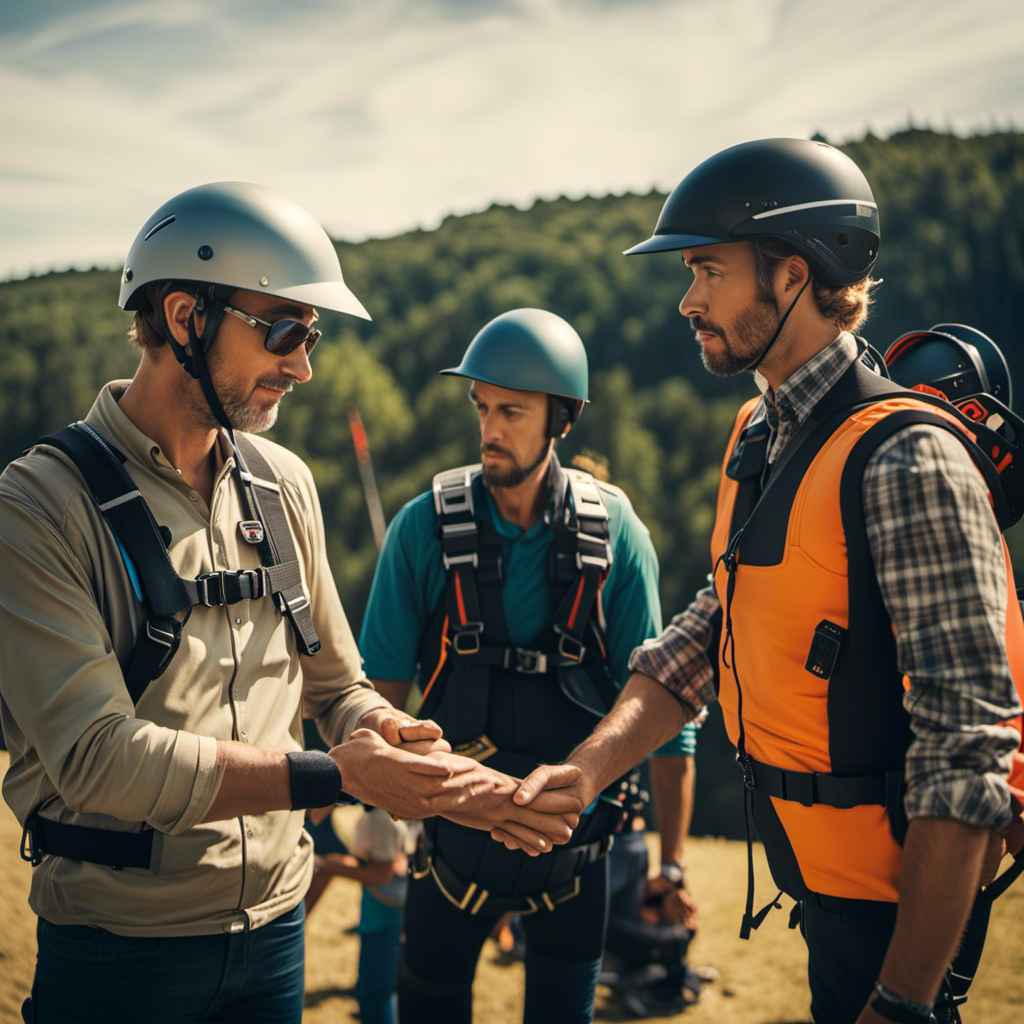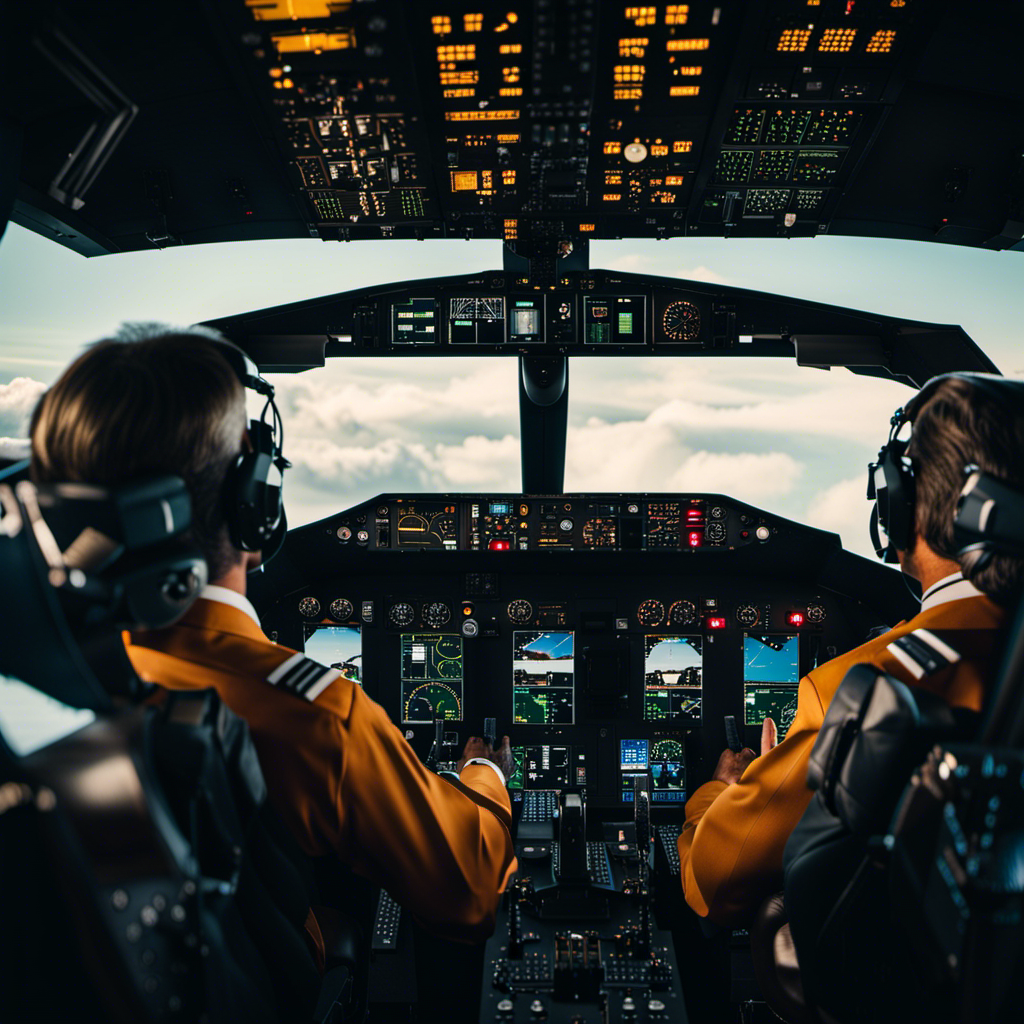Ready to experience the exhilarating feeling of hang gliding and fly high like an eagle? Look no further!
This practical guide will take you through the necessary steps to secure your hang glider license. From understanding the basics to finding a qualified instructor, enrolling in lessons, and passing the exams, we’ve got you covered.
So, get ready to soar through the skies with confidence and join the vibrant hang gliding community.
Let’s make your dreams of flying a reality!
Key Takeaways
- Understanding the basics of hang gliding, including aerodynamics, control techniques, and weather conditions, is essential for securing a hang glider license.
- Researching and choosing a certified hang gliding school with qualified instructors is crucial for receiving thorough instruction and gaining the necessary skills.
- Enrolling in hang gliding lessons that are suitable for your skill level and goals, and setting a consistent training schedule, will help you progress effectively.
- Practicing solo flights, following local regulations and guidance from experienced pilots, is an important part of the training process and contributes to the required training hours.
Understanding the Basics of Hang Gliding
Understanding the basics of hang gliding can be a thrilling and rewarding experience. As you step into this exhilarating world, it is important to familiarize yourself with the fundamental aspects of this sport.
Hang gliding involves piloting a lightweight aircraft called a hang glider, which is designed to soar through the air using the natural elements. You will learn about the aerodynamics of flight, how to control the glider using weight shifting and hand controls, and the importance of wind and weather conditions.
Additionally, you will gain knowledge about pre-flight checks, launching techniques, and landing procedures. These foundational skills will serve as the building blocks for your journey towards obtaining a hang glider license.
Now, let’s delve into the next crucial step – finding a qualified instructor who will guide you through this thrilling adventure.
Finding a Qualified Instructor
When it comes to finding a qualified hang gliding instructor, there are a few key points you should consider.
First and foremost, it’s important to research certified hang gliding schools in your area. Look for schools that have a good reputation and are recognized by the appropriate governing bodies.
Additionally, evaluating instructor experience and qualifications is crucial. Find out how long the instructor has been teaching, their level of certification, and if they have any additional training or specialties.
Researching Certified Hang Gliding Schools
To find the right certified hang gliding school for you, start by checking online reviews and asking experienced hang gliders for recommendations. The internet is a valuable resource that can provide you with insights into the quality of instruction offered by different schools. Look for schools with positive reviews and a track record of producing competent and confident hang gliders.
Additionally, reach out to experienced hang gliders in your network and ask for their recommendations. They can provide valuable firsthand insights into the schools they have trained with and the quality of instruction they received.
Once you have gathered a list of potential schools, it’s time to evaluate the experience and qualifications of the instructors. This will ensure that you receive thorough and professional training that meets your needs.
Evaluating Instructor Experience and Qualifications
If you want to ensure thorough and professional training, take the time to evaluate the experience and qualifications of the instructors. The expertise of your hang gliding instructor plays a crucial role in your learning experience and overall safety. By assessing their background and credentials, you can make an informed decision about who will guide you through this exhilarating journey.
To help you in this process, here is a table outlining key factors to consider when evaluating hang gliding instructors:
| Qualification | Experience | Certification |
|---|---|---|
| Advanced Hang Glider Pilot Rating | Minimum 500 hours of flight time | Certified by a recognized hang gliding association |
| Instructor Training Course Completion | Experience teaching novice and advanced students | Current first aid and CPR certification |
| Safety Record | Knowledge of local flying conditions and regulations | Ongoing professional development |
By thoroughly reviewing each instructor’s qualifications, experience, and certifications, you can choose someone who possesses the necessary expertise to guide you safely through your hang gliding journey. Once you have evaluated the instructors, it’s time to enroll in hang gliding lessons and start your training.
Transition: Now that you have identified qualified instructors, it’s time to take the next step and enroll in hang gliding lessons.
Enrolling in Hang Gliding Lessons
When enrolling in hang gliding lessons, it’s important to consider three key points: choosing the right lesson package, setting a schedule, and budgeting.
The right lesson package will depend on your skill level and goals, whether you’re a beginner or looking to improve your skills.
Setting a schedule that works for you is crucial to ensure consistency and progress in your learning journey.
Lastly, it’s important to budget accordingly, considering the cost of lessons, equipment, and any additional expenses that may arise.
Choosing the Right Lesson Package
Before settling on a lesson package, make sure you’ve thoroughly researched the options available. Hang gliding lessons are a crucial step towards earning your license, so it’s important to choose the right package that suits your needs and goals.
Here’s a list to help you navigate the selection process:
-
Lesson Duration: Consider the length of each lesson and how many lessons are included in the package. Longer lessons may provide more hands-on experience, while a greater number of lessons could offer a more comprehensive learning experience.
-
Instructor Qualifications: Look for instructors who are certified and have ample experience in hang gliding. Their expertise will greatly impact your learning progress and overall safety.
-
Equipment: Ensure that the package includes access to well-maintained hang gliders and safety gear. You want to learn with reliable equipment that meets industry standards.
-
Additional Benefits: Some packages may offer additional perks, such as discounted rates for future lessons or access to exclusive flying sites. Consider these extras when making your decision.
Choosing the right lesson package is just the first step towards securing your hang glider license. Now, it’s time to set a schedule and budget for your training journey.
Setting a Schedule and Budget
To effectively set a schedule and budget for your hang gliding training, consider factors such as your availability, financial resources, and desired timeline.
First, assess how much time you can dedicate to your training. Are you able to commit to regular lessons or do you have a limited schedule? This will help you determine the frequency and duration of your training sessions.
Next, evaluate your financial resources. Hang gliding lessons can vary in cost, so it’s important to establish a budget that aligns with your financial situation.
Additionally, consider your desired timeline. Do you have a specific deadline or are you flexible with your training duration? Taking these factors into account will help you create a realistic schedule and budget for your hang gliding journey.
When it comes to learning the fundamentals of hang gliding, it’s crucial to start with the basics.
Learning the Fundamentals of Hang Gliding
It’s important to start by learning the fundamentals of hang gliding before attempting any advanced maneuvers. Understanding the basic principles and techniques will lay a strong foundation for your future progress in this thrilling sport. Here’s a breakdown of the key fundamentals you need to master:
| Fundamentals | Description | Importance |
|---|---|---|
| Launching | Properly launching your glider is crucial for a successful flight. You’ll learn how to position yourself, control the wing, and use the wind to your advantage. | High |
| Turning | Turning allows you to change direction mid-flight. You’ll discover techniques like weight shifting and using the control bar to execute smooth and controlled turns. | High |
| Landing | Safely landing your glider is essential to avoid injuries. You’ll learn how to approach the landing zone, control your descent, and execute a smooth touchdown. | High |
| Emergency Procedures | Knowing how to handle unexpected situations, such as sudden changes in weather or equipment malfunctions, is vital for your safety. You’ll practice emergency maneuvers and learn to react quickly and decisively. | Medium |
Practicing Solo Flights
Once you have mastered the fundamentals, you can start practicing solo flights to enhance your hang gliding skills. Solo flights are an exciting opportunity to apply what you have learned and gain more confidence in the air.
Before taking off on your own, ensure you have a thorough understanding of pre-flight checks, launching techniques, and emergency procedures. Begin with short flights in calm weather conditions, gradually increasing the duration and complexity as you become more proficient.
Solo flights allow you to refine your flying techniques, improve your judgment, and develop a deeper understanding of the dynamics of hang gliding. It is crucial to remember that solo flights should always be conducted in accordance with local regulations and under the guidance of experienced pilots.
As you gain experience through solo flights, you will be one step closer to completing the required training hours.
Completing the Required Training Hours
When completing the required training hours, make sure you’re consistently logging your flight time and seeking opportunities to fly in various weather conditions. This is crucial for developing your skills and becoming a competent hang glider pilot.
Keep a logbook handy, and record every flight, no matter how short or long it may be. This will not only help you track your progress but also provide evidence of your flight experience when applying for your license.
Additionally, try to fly in different weather conditions, such as calm winds, gusty winds, or even light rain. This will expose you to various challenges and prepare you for real-world flying situations.
Passing the Written and Practical Exams
When it comes to passing the written and practical exams for your hang glider license, there are a few key points to keep in mind.
First, studying for the written exam is crucial and requires a thorough understanding of the rules and regulations, as well as the principles of aerodynamics and meteorology.
Second, demonstrating your skills in the practical exam is equally important, as it showcases your ability to safely operate a hang glider in various conditions.
With the right preparation and practice, you can confidently tackle both exams and move closer to achieving your hang glider license.
Studying for the Written Exam
To ace the written exam for your hang glider license, it’s important to dedicate enough time to studying. Start by familiarizing yourself with the hang glider manual, which covers everything from equipment maintenance to flight procedures.
Pay attention to key concepts such as aerodynamics, weather patterns, emergency procedures, and navigation. Take notes and create flashcards to help you remember important information. Practice answering sample questions to gauge your understanding and identify areas that need improvement.
Additionally, consider joining study groups or seeking guidance from experienced hang glider pilots who can provide valuable insights.
Once you have demonstrated your knowledge in the written exam, it’s time to focus on demonstrating your skills in the practical exam.
Demonstrating Skills in the Practical Exam
You’ll want to make sure you are prepared to showcase your skills in the practical exam by practicing maneuvers such as takeoff, landing, and controlling the hang glider in different wind conditions.
Here are three key areas to focus on during your practice sessions:
-
Takeoff: Mastering the art of a smooth takeoff is crucial. Practice launching your hang glider with precision, ensuring that you maintain a steady ascent and control the glider’s pitch and roll as you gain altitude.
-
Landing: Landing safely is just as important as taking off. Practice your approach and touchdown techniques, aiming for a smooth and controlled landing. Learn to read the wind conditions and adjust your landing strategy accordingly.
-
Wind control: Wind conditions can greatly affect your flight. Practice flying in varying wind speeds and directions, learning how to adjust your wing control to maintain stability and control throughout the flight.
Obtaining the Hang Glider License
First, make sure you’ve completed the necessary training to obtain your hang glider license. This includes learning the fundamentals of hang gliding, practicing launching and landing techniques, and understanding safety procedures.
Once you feel confident in your skills, you can apply for the license through the appropriate governing body in your country. They will assess your knowledge and abilities through written exams and practical assessments. It’s crucial to demonstrate your competence in areas such as emergency procedures, meteorology, airspace regulations, and navigation.
Once you pass the exams and meet the requirements, you’ll receive your hang glider license, allowing you to legally fly on your own.
Now, as you become a licensed hang glider pilot, it’s a great time to consider joining hang gliding communities and clubs, where you can connect with experienced pilots, participate in group flights, and continue learning from others who share your passion for the sport.
Joining Hang Gliding Communities and Clubs
When it comes to joining hang gliding communities and clubs, there are a few key points to keep in mind.
First, connecting with experienced pilots can be incredibly valuable as they can offer guidance, advice, and share their wealth of knowledge.
Additionally, participating in group flights and events not only allows you to learn from others but also fosters a sense of camaraderie and community within the sport.
These opportunities provide a platform for growth and improvement as you interact with fellow enthusiasts who share your passion for hang gliding.
Connecting with Experienced Pilots
Talking to experienced pilots is a great way to gain valuable insights and knowledge about hang gliding. These seasoned flyers have accumulated years of experience and can offer you valuable advice and guidance as you embark on your hang gliding journey.
Here are some key reasons why connecting with experienced pilots is essential:
-
Learn from their mistakes: Experienced pilots have encountered various challenges and learned from their own mistakes. By listening to their stories, you can avoid common pitfalls and make more informed decisions.
-
Discover new flying spots: Experienced pilots have explored numerous flying spots and can recommend the best locations based on your skill level and preferences.
-
Get tips on equipment: They can provide valuable recommendations on hang gliding equipment, ensuring you invest in gear that suits your needs.
-
Gain confidence and inspiration: Interacting with experienced pilots can boost your confidence and inspire you to achieve new heights in your hang gliding journey.
By connecting with experienced pilots, you can tap into a wealth of knowledge and expertise, setting yourself up for a successful hang gliding experience.
Transitioning into the subsequent section about participating in group flights and events, you can continue to expand your network and further enhance your hang gliding skills.
Participating in Group Flights and Events
Participating in group flights and events allows you to connect with other hang gliding enthusiasts and learn from their experiences. These gatherings provide a unique opportunity to engage with a diverse community of pilots who share your passion for the sport.
By joining group flights, you can observe and interact with experienced hang gliders, gaining valuable insights into their techniques and strategies. These events often feature workshops, where seasoned pilots offer guidance on various aspects of hang gliding, such as launching, landing, and navigation.
Moreover, group flights foster a sense of camaraderie and support, as you can exchange tips, troubleshoot challenges, and form lasting friendships. By immersing yourself in these group activities, you can enhance your knowledge and skills, preparing yourself for the next phase of your hang gliding journey: continuing education and skill development.
Continuing Education and Skill Development
To stay up-to-date with the latest techniques and safety protocols, it’s important to keep taking classes and practicing regularly. As a hang glider pilot, continuing education and skill development are paramount to ensuring a safe and enjoyable flying experience. Here are three key ways to further enhance your knowledge and abilities:
-
Attend advanced training workshops: These specialized workshops focus on specific aspects of hang gliding, such as thermalling techniques or advanced maneuvers. They provide valuable insights and hands-on practice to improve your flying skills.
-
Join a hang gliding club: Being part of a hang gliding club not only offers a sense of community but also provides access to experienced pilots who can mentor and guide you. Club events and gatherings are great opportunities to learn from others and gain valuable insights.
-
Participate in competitions: Competing in hang gliding competitions pushes you to your limits and exposes you to different flying conditions. It allows you to test your skills against other pilots and learn from their techniques, ultimately helping you grow as a pilot.
Conclusion
Congratulations on completing the journey towards securing your hang glider license! By enrolling in hang gliding lessons and practicing solo flights, you have proven your dedication and determination. Just like a bird soaring through the sky, you have spread your wings and conquered the heights.
Obtaining your hang glider license is not just a piece of paper, but a symbol of your passion and skill. As you join hang gliding communities and clubs, continue to soar higher and push your limits. Remember, the sky is not the limit, it’s just the beginning of your endless possibilities.









